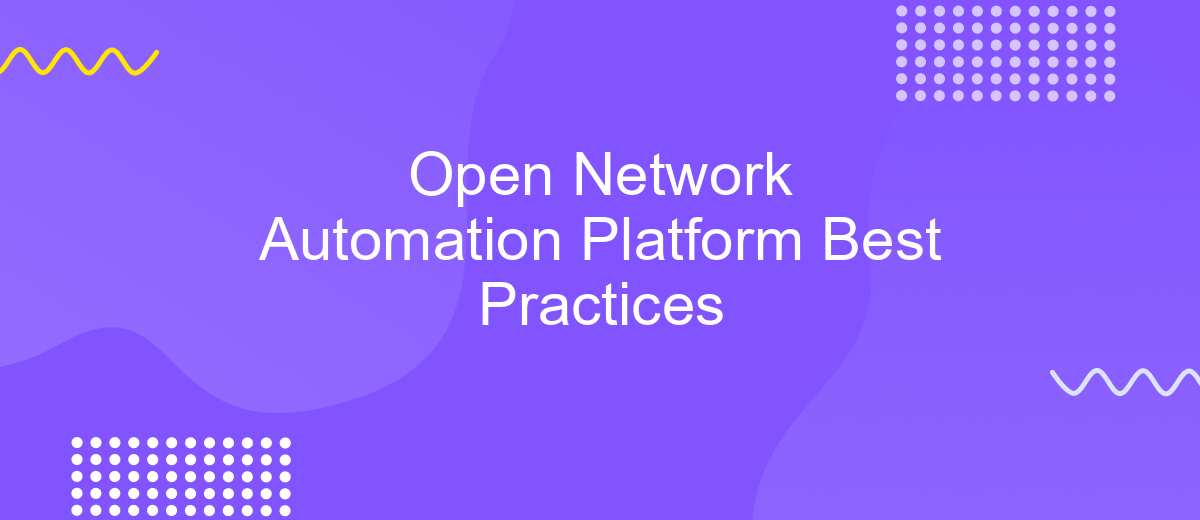Open Network Automation Platform Best Practices
The Open Network Automation Platform (ONAP) is revolutionizing the way organizations manage and automate their network services. By leveraging ONAP's robust framework, businesses can achieve greater efficiency, scalability, and flexibility. This article explores best practices for implementing ONAP, ensuring that you maximize the potential of this powerful platform while avoiding common pitfalls and optimizing performance.
Introduction
Open Network Automation Platform (ONAP) has emerged as a critical framework for managing and automating network services. It offers a comprehensive solution for service providers to design, orchestrate, and manage the full lifecycle of network functions. As organizations continue to adopt ONAP, adhering to best practices becomes essential for maximizing efficiency and ensuring seamless operations.
- Standardize deployment processes to ensure consistency across environments.
- Implement robust security measures to protect sensitive data and network integrity.
- Utilize automated testing to identify and resolve issues early in the development cycle.
- Leverage modular architecture to facilitate scalability and flexibility.
- Engage in continuous monitoring to maintain optimal performance and reliability.
By following these best practices, organizations can effectively leverage ONAP to streamline network operations, reduce operational costs, and enhance service delivery. As the network landscape evolves, staying updated with the latest advancements and methodologies in ONAP will be crucial for maintaining a competitive edge.
Planning and Design

Effective planning and design are crucial for the successful implementation of the Open Network Automation Platform (ONAP). Begin by thoroughly assessing your network's current state and identifying specific goals for automation. This includes understanding the existing infrastructure, pinpointing areas that require automation, and defining performance metrics. Collaborate with stakeholders to gather requirements and ensure alignment with business objectives. Utilize architectural frameworks to map out the integration of ONAP with existing systems, ensuring scalability and flexibility for future expansions.
When designing the ONAP solution, consider leveraging integration services like ApiX-Drive to streamline the process. ApiX-Drive facilitates seamless data exchange between ONAP and other applications, reducing manual efforts and minimizing errors. Plan for robust security measures to protect sensitive data and ensure compliance with industry standards. Develop a detailed roadmap that includes timelines, resource allocation, and risk management strategies. By meticulously planning and designing your ONAP deployment, you can achieve a more efficient, reliable, and scalable network automation solution.
Implementation and Deployment

Implementing and deploying the Open Network Automation Platform (ONAP) requires a structured approach to ensure efficiency and reliability. Before starting, it is crucial to have a clear understanding of your network requirements and the specific features of ONAP that align with those needs.
- Assess and document your network's current state and desired outcomes.
- Set up a dedicated environment for ONAP installation, ensuring all hardware and software prerequisites are met.
- Follow the official ONAP installation guide, paying close attention to configuration settings.
- Conduct thorough testing in a staging environment to identify and resolve any issues.
- Deploy ONAP to the production environment, monitoring performance closely during the initial phase.
Post-deployment, it is essential to establish a robust monitoring and maintenance routine. Regular updates and patches should be applied to keep the platform secure and functioning optimally. Continuous feedback loops with network operators can help in refining and improving the deployment over time.
Operation and Maintenance

Effective operation and maintenance of the Open Network Automation Platform (ONAP) are crucial for ensuring seamless network automation and service delivery. It involves continuous monitoring, timely updates, and proactive troubleshooting to maintain optimal performance and reliability.
To achieve this, operators must implement a robust strategy that includes regular system audits, performance evaluations, and adherence to best practices. This approach helps in identifying potential issues before they escalate, thereby minimizing downtime and enhancing the overall efficiency of the network.
- Conduct regular system health checks and audits.
- Implement automated monitoring and alerting mechanisms.
- Ensure timely updates and patches to the ONAP components.
- Maintain comprehensive documentation of configurations and changes.
- Engage in continuous training and skill development for the operations team.
By following these best practices, organizations can ensure the smooth operation and maintenance of the ONAP environment. This not only enhances the reliability and performance of network services but also contributes to a more resilient and adaptable network infrastructure.
Continuous Improvement and Optimization
Continuous improvement and optimization are essential for maintaining the efficiency and effectiveness of the Open Network Automation Platform (ONAP). Regularly reviewing performance metrics and user feedback allows teams to identify areas for enhancement. Implementing automated testing and monitoring tools ensures that the platform runs smoothly and any issues are promptly addressed. Additionally, benchmarking against industry standards helps in setting realistic goals and measuring progress.
Integrating services like ApiX-Drive can greatly facilitate these processes. ApiX-Drive enables seamless data integration between various tools and platforms, ensuring that all relevant information is easily accessible for analysis. This integration allows for more informed decision-making and quicker adjustments to the system. By leveraging such services, organizations can streamline their workflows, reduce manual errors, and continuously optimize their ONAP deployments for better performance and reliability.
FAQ
What is Open Network Automation Platform (ONAP) and why is it important?
What are the best practices for implementing ONAP in an existing network infrastructure?
How can I ensure seamless integration of ONAP with my existing tools and systems?
What are some common challenges when adopting ONAP, and how can they be mitigated?
How can I measure the success of ONAP implementation in my organization?
Time is the most valuable resource for business today. Almost half of it is wasted on routine tasks. Your employees are constantly forced to perform monotonous tasks that are difficult to classify as important and specialized. You can leave everything as it is by hiring additional employees, or you can automate most of the business processes using the ApiX-Drive online connector to get rid of unnecessary time and money expenses once and for all. The choice is yours!

